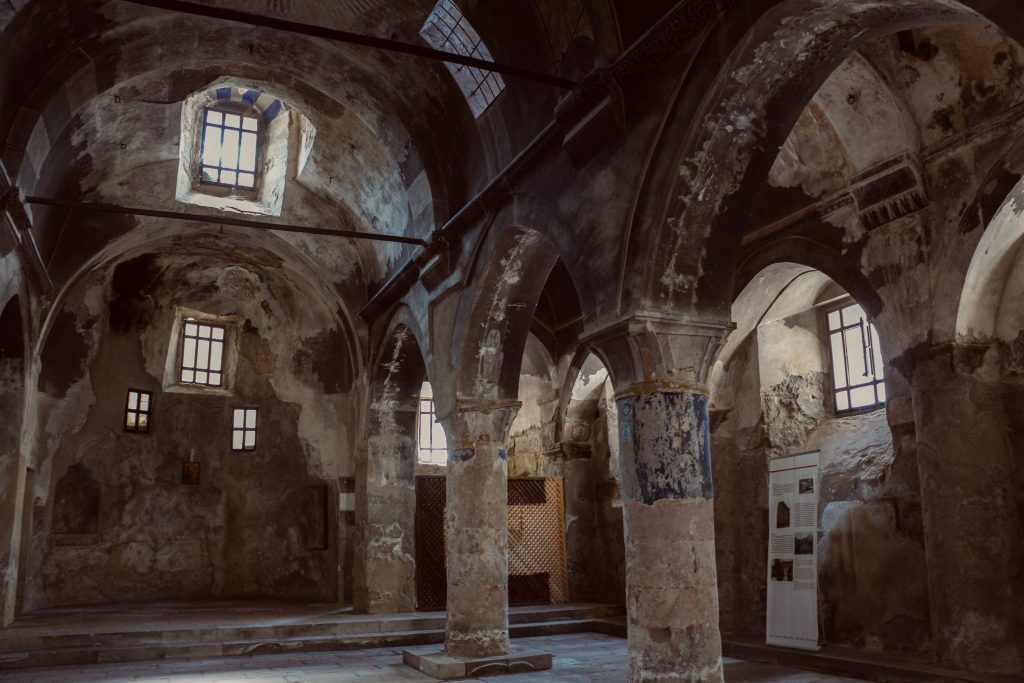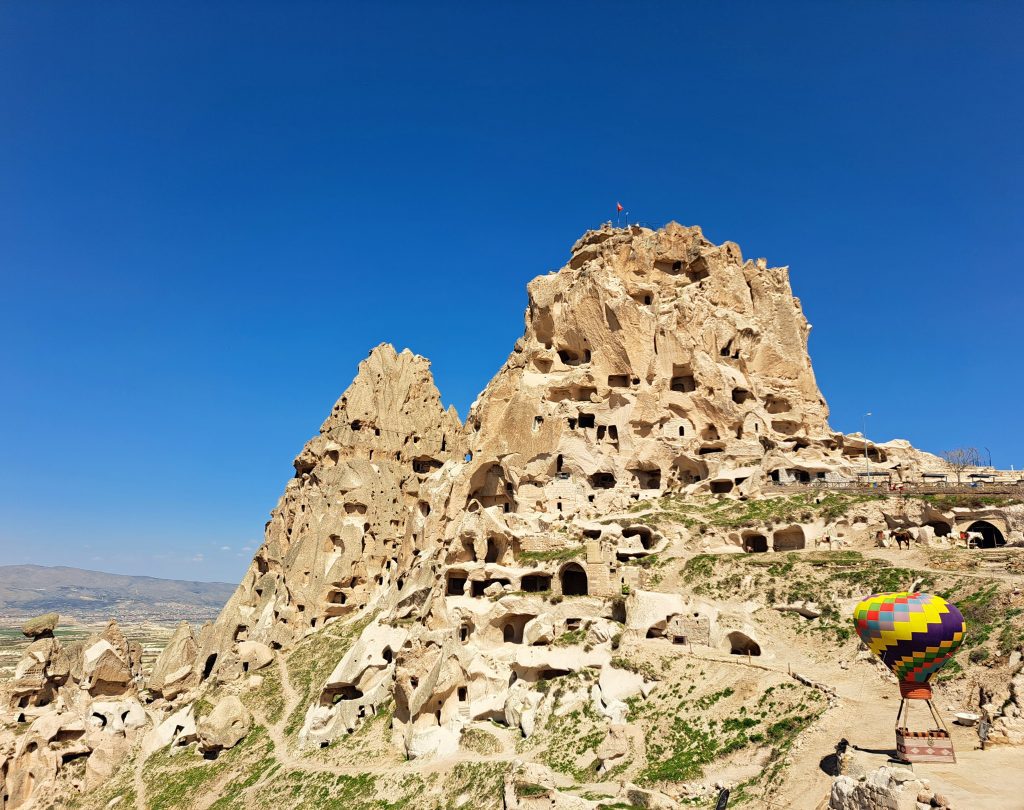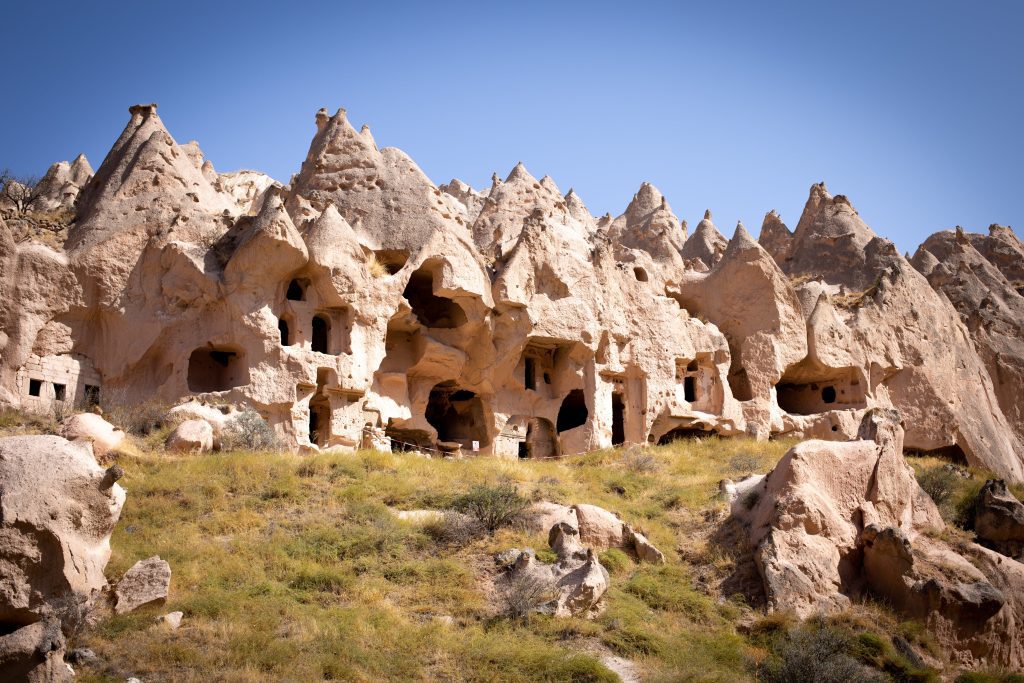Nevşehir is undoubtedly the first city that comes to mind when travellers think of visiting the Cappadocia region. Cappadocia has a unique geography that had been shaped by natural forces. Millions of years ago, volcanic eruptions from nearby mountains (active volcanoes back then) enveloped the region in lava and thick ash, which solidified into a type of soft rock called tuff. This thick layer of tuff was slowly eroded by wind and water, resulting in the creation of cones, pillars, mushroom-shaped pinnacles and chimneys. In time, humans settling in the area added to nature’s creations and carved an incredible chamber and tunnel complex into the soft rock. They built caves, living quarters, places of worship, and even stables. In certain places, these man-made tunnel complexes made up entire towns going back several layers (up to eight stories) underground. As a result, the plateau became an urbanized but underground cultural landscape with a unique architecture.
The most famous about Nevşehir are the fairy chimneys for sure! Most of the region’s fairy chimneys and rock-cut churches are found at Ürgüp, Avanos, Gülşehir, Uçhisar and Göreme.
Göreme Valley and Open-Air Museum

With a spectacular landscape entirely sculpted by erosion, the Göreme Valley (Göreme Vadisi) and its surroundings contain rock-hewn sanctuaries that provide unique evidence of Byzantine art in the post-iconoclastic period.
The area also contains the villages of prehistoric cave dwellers and underground cities of traditional human habitation. Included in UNESCO’s World Heritage Sites List, Göreme keeps unique natural features that display a harmonious combination of natural and cultural landscape elements.
Göreme National Park and the Rock Sites of Cappadocia

Located among the “fairy chimney” rock formations, Göreme is a town in the Nevşehir province. With a spectacular landscape entirely sculpted by erosion, the Göreme Valley (Göreme Vadisi) and its surroundings contain rock-hewn sanctuaries that provide unique evidence of Byzantine art in the post-iconoclastic period. The area also contains the villages of prehistoric cave dwellers and underground cities that include the remains of human habitation dating back to the 4th century. Göreme contains unique natural features and displays a harmonious combination of natural and cultural landscape elements.
Göreme and its environs, located 10km from Nevşehir, are thought to have been used as a necropolis by the inhabitants of Venessa (Avanos) during Roman times.
The churches of Durmuş Kadir, Yusuf Koç, El Nazar, Saklı, Meryem Ana (Virgin Mary) and Kılıçlar cast a spellbinding effect on visitors. The Göreme Open Air Museum (Göreme Açık Hava Müzesi) is where the ideas of Christianity were unified by St. Basil the Great and his brothers.
The architectural details and frescoes of the Tokalı Church, Convent of Monks and Nuns, Chapel of St. Basil, St. Barbara and The Elmalı, Yılanlı, Karanlık and Çarıklı Churches seem as vivid today as when they were new.
Çavuşin, located 2 km from Göreme, is one of the oldest inhabited places in the region and the fresco scenes of Çavuşin Church (Çavuşin Kilisesi) are distinctive because of their unusual compositions.
Ürgüp and Mustafapaşa Village

In Ürgüp, 20km east of Nevşehir, the St Theodore (Tağar) and Pancarlık Churches are elaborately decorated with religious art. Six kilometres south of Ürgüp is Mustafapaşa (Sinasos), a town justifiably famous for its splendid stone works.
The Chapel of St Basil (Aziz Basil Şapeli) is decorated with motifs reflecting the iconoclastic system of thought in Gomeda Valley (Gomeda Vadisi). A hot-air balloon in a voyage unique to the Cappadocian region is an experience unlike any other as you race with the doves through the sky’s shades of blue and behold below the sinuous terrain extending into infinity, the enigmatic and artistically magnificent churches, and the pyramids, cones, mushrooms, and hats of the fairy chimneys. Ürgüp is also known for its wine that has been produced in the area for thousands of years and visitors can’t resist the taste of the crimson-red or misty-white wines from the fertile vineyards in which the grapes of the Cappadocia region flourish. Although some local vintners have adopted modern techniques of winemaking, there are still many that remain faithful to ancient and time-proven methods.
Ortahisar, 6 kilometres away from Ürgüp, is home to the once strategically important Ortahisar citadel with fine examples of Cappadocia’s vernacular architecture clustered around its base. Another must-see site is the Üzümlü Church (Üzümlü Kilisesi) on the western side.
Uçhisar

Uçhisar, a charming village, located 6 kilometres away from Nevşehir, is a perfect example of Cappadocia’s unique architecture. Uçhisar Rock Castle (Uçhisar Kalesi) is a perfect spot to watch the scenery and take pictures. After exploring the town centre, your next stop should be Güvercinlik (the Valley of Pigeons). This long, deep canyon is home to rock churches, tunnels and pigeon nests carved in rocks. It is also a 4-kilometre trail offering spectacular views and ideal for hiking.
Avanos and Çavuşin

One of Cappadocia’s oldest settlements, Avanos is another must-see. Due to its distinctive red clay, this town has been a centre of pottery making since the Hittites. You can observe artists making their creations in one of the workshops and try fashioning one yourself with the help of an expert.
The nearby village of Çavuşin with its rock-cut houses is also worth visiting. Kızılçukur Valley (Kızılçukur Vadisi) further along the road is a popular spot for watching the sunset, which is a must for every visitor to Cappadocia.
You can visit the local markets offering a variety of interesting items from handwoven fabrics to model fairy chimneys. Also, be sure to try the local cuisine, especially traditional dishes such as “testi kebab” and “sac kavurma” (lamb and vegetables fried on iron plate).
Underground Cities of Kaymaklı and Derinkuyu

There are great number of underground settlements across Cappadocia while new ones are being discovered. People continued to work on the underground cities during also Roman and Byzantine periods, adding their own cultural and religious signatures such as churches. During their peak, these cities sheltered thousands of people.
South of Nevşehir, the road takes you to the underground cities of Kaymaklı and Derinkuyu respectively. Situated deep below Kaymaklı Castle (Kaymaklı Kalesi), Kaymaklı Underground City (Kaymaklı Yeraltı Şehri) features a maze of tunnels and rooms carved eight levels deep into the earth. The first floor was used as a stable, while the other levels include living quarters, a church and even graves. Nine kilometres from Kaymaklı, Derinkuyu (means “deep well” in Turkish) takes its name from the depth of the water wells here. It is a complex network of tunnels and rooms spread to seven levels consisting of stables, cellars, dining halls, churches and storage areas.
Hacı Bektaş-ı Veli Museum

With the arrival of Islam, Anatolia became the home to a number of famous Muslim scholars and philosophers. At the 13th century the Turkish and Muslim mystic Hacı Bektaş-ı Veli settled in the Nevşehir county known as Hacıbektaş today. The core tenets of this his philosophy, crucial to achieving unity among the different Turkish groups in Anatolia, embody the spirit and substance of the 1948 Universal Declaration of Human Rights. The town of Hacıbektaş, 45 kilometres from Nevşehir, has a 14th-century külliye (Islamic complex) that includes the tomb of Hacı Bektaş-ı Veli, a mosque, guesthouse, kitchen, wishing tree and an area for ascetics. The complex which is now a museum has been inscribed in the Tentative List of UNESCO’s World Heritage.
On 16-18 August every year, activities commemorating Hacı Bektaş-ı Veli are held and draw large crowds of his disciples as well as interested visitors.
Nevşehir Museum

If you are interested in the local culture of the city you visited, Nevşehir Museum (Nevşehir Müzesi) is the right place for you. The museum combines the distant and recent past of Nevşehir. At the Archaeological Exhibition Hall, you can see Neolithic, Chalcolithic, Bronze Age, Iron Age, Archaic, Hellenistic, Roman, Byzantine, and Mesopotamian artefacts and bronze, silver and gold coins of various periods. The tear bottles, bracelets, glasses and beads in various forms belonging to the Roman Period are among the important works of the collection. Terracotta’s, marble goddess head and Apollo statuette and oil lamps from this period are also included besides a vast collection of coins of the Roman, Seljuk and Ottoman periods.
Folkloric artefacts of Nevşehir and the region, which is a part of Anatolian culture, are exhibited in the Ethnographic Exhibition Hall. The establishment style of traditional carved homes and churches, agriculture methods, traditional kitchen, making of molasses from the tasty grapes of Nevşehir, handmade carpet making methods, Turkish bath, traditional village room and a honeymoon suit are the examples of what you will see at Nevşehir Museum. You can also have a souvenir photo as “Ortahisar Hatırası” to keep the memory of this visit!












